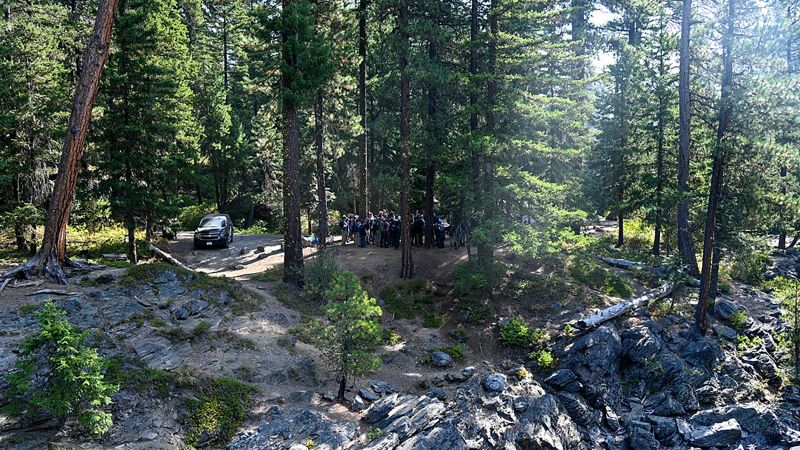How a monthslong hunt for a fugitive father brought investigators right back to where they started

Investigators spent the summer combing the wilderness of the Washington Cascades for Travis Decker – the man thought to have killed his three young daughters at a campground at the end of May. A backdrop of rugged mountains and scenic trails gave way to specialized search teams, helicopters and dogs as officials attempted to track down the fugitive father, with the search even crossing over the border into Canada and Mexico as tips were chased down.
But when investigators found fragments of bone believed to belong to Decker on Thursday, they were less than a mile away from the abandoned campsite where the girls’ bodies were discovered on June 2, each suffocated with multiple plastic bags over their heads.
The brutal deaths sent shockwaves across the popular tourist destination as officials cautioned residents that Decker — an Army veteran skilled in wilderness survival — should be considered dangerous.
The search for Decker has been complicated by the fact that he’d had a three-day head start in a rural area known for its wild beauty and treacherous terrain in the Cascade mountain range outside the city of Leavenworth.
Drones, a swift water team, cadaver dogs and GoPros punctured the peace in the tranquil and majestic mountains and triggered a closure of the Enchantments, an area popular for backcountry hiking and camping, as law enforcement scoured the forest for any signs of the bearded Army veteran.
Investigators were searching a remote and virtually uninhabitable area on Grindstone Mountain this week when a drone flying overhead detected something unusual in a thicket of trees.
“It was an area that we had not gotten to search in that kind of detail yet. So we deployed drones, other resources, and it was where we had aimed to search next,” Chelan County Sheriff Mike Morrison told CNN on Friday.
The area is “steep,” the sheriff said. “It is thickly brushed. It’s not populated. It is not a travel trail. It is not an area that people typically frequent.”
Investigators rappelled down to the site, where they discovered bone fragments and other remains, along with personal items, including the shirt and shorts that matched those Decker was last seen in.
The bone fragments were scattered – likely the result of animals scavenging, Morrison added.
The discovery brings a possible end to a frustrating months-long search effort that cost millions of dollars, but a slew of questions about the case are still unanswered.
The human remains have yet to be positively identified as Decker’s, and it’s unclear how – or when – the person died.
Decker hadn’t been seen since May 30, when he failed to return daughters 5-year-old Olivia, 8-year-old Evelyn and 9-year-old Paityn to their mother, his ex-wife, Whitney Decker after a three hour scheduled custody visit.
Just a month after Decker disappeared, the Kittitas County Sheriff’s Office, which assisted in the manhunt, had said they had no indication Decker was alive, or that he was in the area near the crime scene.
And there had been no trace of him – no credit card transactions, no phone activity – since the girls were killed, Morrison said Friday.
A sudden breakthrough
The patch of Grindstone Mountain where the bone fragments were found is at a little over 4,000 feet of elevation and just under ¾ of a mile away from the crime scene where the Decker sisters were discovered.
“That’s straight uphill. You’re almost looking like a little over 1,000 feet of elevation gain in a little bit of distance,” Morrison said. “It would take almost three hours to hike in there, just based off the terrain and the rock formations.”
Unlike other parts of the Cascades, where campgrounds are plentiful and the Pacific Crest Trail attracts hundreds of hikers, this area is desolate.
“There was nothing in that area,” Morrison said. “There were no campsites. There’s no trails, there’s no climbing routes. It’s just wilderness.”
After they landed on the mountainside, detectives hiked an hour to get back down from the steep, trailless slope.
“Thankfully, we’ve got detectives who are in pretty good shape,” Morrison said. “They’re used to hunting in the backcountry, so they’re used to the terrain. And they accepted the challenge.”
Guy Mansfield – a longtime search and rescue volunteer in Washington state who serves as a director of the Washington State SAR Planning Unit – told CNN that the search area around the campground was rough and vast, complicating search efforts.
“Thoroughly searching in a 2-mile radius from the campground would involve an area approaching 3,000 acres of rough terrain,” he said.
It likely would have been difficult to deploy ground teams and K-9 units to the remote mountainside where the remains were found, according to Mansfield, who was not involved with the search.
When remains are scattered by animals – as seems to have happened with the remains found Thursday – they’re much more difficult to identify, he added.
And searchers had to plan for two wildly different contingencies, Mansfield explained: That Decker was extremely close to the crime scene – or that he was very far away. “This would have spread search resources thin,” he said.
Trey Werner, the founder and executive director of Washington-based Wilderness Search Investigations, added that even from a drone, a motionless body would be very difficult to identify in heavy brush.
Questions unanswered
It’s difficult to say how long the remains had been on the mountainside, according to Morrison. Decomposition was “well, well in place,” he said.
For the family members left grieving, and the public, the events after Decker’s disappearance remain a mystery. The coroner’s office will provide more information later about a possible cause and time of death, Morrison said.
The sheriff said that he had requested to expedite the lab work needed to identify the remains. But they don’t know yet when they’ll get those answers.
DNA profiles are the most reliable method for identifying skeletal remains, according to Dr. Nicole Jackson, attending pathologist and director of Autopsy & After Death Services at the University of Washington Medicine Hospital. But a successful match can take weeks or even months – and the more degraded the remains, the harder they can be to identify.
Jackson added that forensic pathologists tend to give ranges for the time period when a person died, rather than precise dates, because it’s so difficult to determine.
Skeletonization can take weeks to month to years, depending on the conditions, she told CNN.
Authorities have also yet to say why they think Decker killed his daughters. The sheriff said no note was found among the personal items by the human remains.
Morrison said the case is an emotional one, for his deputies – whom he’s required to talk to psychologists to take care of their mental health – and for himself.
“These weren’t even my daughters, but it certainly hit home,” he said.
A veteran with survival skills on the run
As the manhunt for Decker began, authorities had warned that Decker should be considered dangerous, though they didn’t know if he was armed.
And his outdoor skills might have made him harder to track and find: An army veteran whose eight years of service included a tour in Afghanistan, he was an avid hiker and hunter and had previously lived “off the grid in the backwoods” for up to two and a half months at a time, a deputy US Marshal said in a court affidavit.
He likely escaped on foot after abandoning his truck near the girls’ bodies, Morrison has told CNN. He also left behind equipment – and his dog – so he was unprepared unless he stashed supplies out in the woods.
Still, Decker had “training in navigation, woodland/mountainous terrain, long distance movements, survival and numerous other disciplines needed to be able to flee from the Eastern District of Washington,” the affidavit added.
Werner, who was not involved in the search for Decker, told CNN that to survive for weeks, he would have needed extensive knowledge about which plants in the area were safe to eat and how to hunt and prepare wildlife to eat. And he would’ve needed a water source and some kind of shelter to survive varying weather conditions.
He had been homeless at the time of his disappearance, living on campgrounds and in motels, Whitney Decker told investigators.
But the sheriff cautioned that even with Decker’s background, he couldn’t hide out forever.
“We’re not going to glorify his abilities. We don’t think that he’s some kind of special forces guru,” Morrison had said. “He could get lucky at times, and eventually luck runs out.”
Local authorities have said there was no sign that anyone was helping Decker.
Her former husband had been diagnosed several years ago with borderline personality disorder, Whitney Decker told investigators. The diagnosis can involve “extreme mood fluctuations, instability in interpersonal relationships and impulsivity,” the Cleveland Clinic says.
Decker had refused to sign his and Whitney’s most recent parenting agreement, which required him to seek mental health treatment and anger management, she told police.
Still, Whitney Decker said her ex-husband’s dog and his daughters “are the two big positives in his life,” according to the affidavit.
“He was very active with their extracurricular activities, their dance, their soccer games, all of those things. He was very involved,” her family attorney has previously said.
The last time she saw Travis Decker, he was a little quieter than usual but otherwise seemed fine. Whitney Decker kissed and hugged their daughters goodbye like she always did – not knowing it would be the last time she saw them alive.
Exhaustive search efforts
Federal and local authorities seemingly employed every tool in their toolkits as they hunted for Decker, who was charged with murder and kidnapping after his daughters’ bodies were discovered.
They slowly expanded their search, starting just a quarter mile radius from the campground and working their way out, Morrison explained.
In July, Morrison estimated that the search had already cost “well over” $6 million. It would have cost half his department’s budget for the year had it not been for the help of other agencies, including the National Park Service, National Forest Service, US Customs and Border Protection, the FBI and the US Marshal Service.
The search even extended as far north as Canada and as far south as Mexico.
In the days before he kidnapped his daughters, Decker had searched on Google for “how does a person move to Canada” and similar phrases, the US Marshals said in their court filing. Marshals noted that Decker’s campsite was less than a dozen miles from the Pacific Crest Trail, which “leads directly to Canada.”
“We worked with the Royal Canadian Mounted Police,” Morrison previously told CNN. “They were doing some follow-up on some leads we had up in Canada.”
They also received tips in Mexico and did their best to follow up, Morrison said.
The months-long search was interrupted by several false alarms that offered hope Decker had been found.
In June, reports emerged that Decker had been spotted in McCall, Idaho. But Morrison later clarified that the person wasn’t Decker.
And in late August, the FBI discovered bones during a grid search for Decker. But a review later established that they weren’t human.
The US Marshals Service had offered a $20,000 award for information leading to Decker’s arrest. He was considered the sole suspect in his daughters’ killings.
A mother’s grief
Although the hunt for Decker may be over, the tragedy wrought on his family is lasting.
The three girls’ “light touched so many, and the pain of this loss is immeasurable,” reads the description for a GoFundMe for Whitney Decker. The fundraiser has raised over a million dollars to help the grieving mother “cover final expenses, support time off from work, and give her space to heal without financial pressure.”
Whitney Decker’s attorney, Arianna Cozart, told ABC News, “We are praying that the remains found are confirmed to be Travis’s. We continue to be grateful for law enforcement’s efforts in this case and are forever appreciative of the entire world’s love, compassion, and support for Whitney.”
CNN has reached out to Cozart for comment.
At a public memorial service in June, attendees wore purple, pink, and green – the girls’ favorite colors. Teachers, friends, and family members shared stories of three vibrant children who loved theater and were quick to laugh.
Tyler Scharlau, who worked with the girls at the YMCA and at their elementary school, said that all three “brought something special into the lives they touched.”
Peyton had been the first to show a new student around when she arrived at the school, he remembered.
“She had a way with making others feel included, making sure no one was left behind, not because she had to, but because it was simply who she was,” Scharlau said.
Whitney Decker said that she was grateful for the time she had with her daughters before their lives were cut short.
“I truly hope that the legacy of the girls’ lives lives on in everyone’s heart forever,” she said, tearing up. “They were incredible.”



